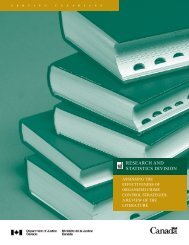National Threat Assessment 2008. Organised Crime - Politie
National Threat Assessment 2008. Organised Crime - Politie
National Threat Assessment 2008. Organised Crime - Politie
Create successful ePaper yourself
Turn your PDF publications into a flip-book with our unique Google optimized e-Paper software.
• making several stopovers, whereby various ports are visited to create<br />
confusion in the paper trail and to make it difficult to trace illegal loads<br />
(this is known as ‘port hopping’);<br />
• using legal trade routes to conceal the illegal activities (e.g. transporting<br />
domestic waste labelled as ‘waste paper’ to a country such as India, which<br />
is often the destination for waste paper transports);<br />
• not following the appropriate procedure (notification/permission) or forging<br />
documentation;<br />
• frequently changing the owner of the waste, which creates greater<br />
confusion;<br />
• using detours for transports. Until 2006, for example, Hong Kong was a<br />
frequently used detour en route to China, as waste legislation in Hong Kong<br />
used to be vague. Fishing boats were used at night to transport shipments<br />
from Hong Kong directly to China.<br />
3.5.3 Scale<br />
The overall market for waste and recycling in the Netherlands in 2005 was<br />
estimated at around 10 billion euros. The overall market consists of the waste<br />
collection and processing market (5.1 billion), the recycling market (1.2 billion)<br />
and the group of companies that trade in waste materials (3.9 billion).<br />
According to data from CBS, the total amount of waste in the Nether lands in<br />
2005 was 71,956 kilotons, of which more than 61,000 kilotons were created<br />
in the Netherlands itself. According to CBS, the total amount of waste exported<br />
from the Netherlands was almost 12,500 kilotons. This was not only waste<br />
generated in the Netherlands, but also waste that was first imported into the<br />
Netherlands (i.e. both export and transhipment of waste). It is difficult to<br />
establish to what extent the shipment of waste involves criminal activities.<br />
The chance of violations being detected is small in the waste sector. Indications<br />
of the scale of violations can be derived from inspections. The Inspectorate of<br />
the Ministry of Housing, Spatial Planning and the Environment has established<br />
that violations occur regularly during the transport and processing of waste<br />
materials. Violations include failure to follow the correct procedures, handling<br />
waste materials that do not meet the prescribed criteria or processing waste<br />
other than in the prescribed manner.<br />
During enforcement operations in 2003, a total of 1709 inspections to check<br />
compliance with the EU Regulation on the Shipment of Waste were performed<br />
in the Netherlands. Violations were found in more than 20% of the inspections.<br />
A report published in 2006 about IMPEL-TFS Seaport Project II revealed that<br />
violations occur quite regularly in cross-border waste transports at the European<br />
chapter 3 – Fraud and money laundering<br />
123








